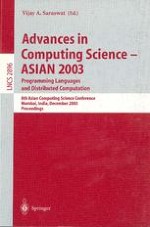2003 | Buch
Advances in Computing Science – ASIAN 2003. Progamming Languages and Distributed Computation Programming Languages and Distributed Computation
8th Asian Computing Science Conference, Mumbai, India, December 10-12, 2003. Proceedings
herausgegeben von: Vijay A. Saraswat
Verlag: Springer Berlin Heidelberg
Buchreihe : Lecture Notes in Computer Science
Enthalten in: Professional Book Archive
